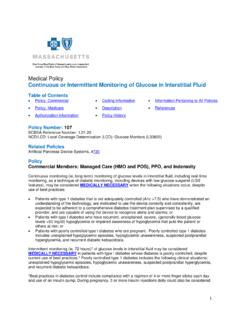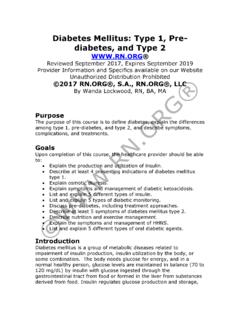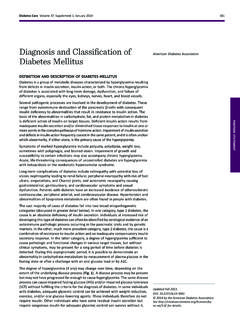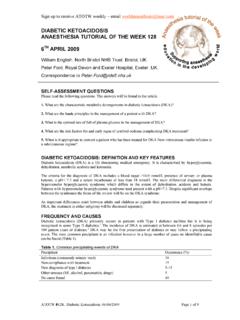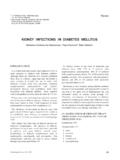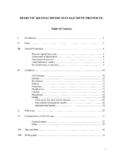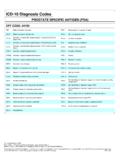Transcription of Diabetes Mellitus - OPL
1 Diabetes Mellitus Bahia Chahine, RPh, PharmD Saturday, February 4, 2017 Learning Objectives 2 Recognize the role of pharmacists in Diabetes care. Define Diabetes Mellitus (DM). Compare and contrast type 1 and 2 diabetes presentation, onset, progression, and pathophysiology. List the plasma glucose levels that diagnose a patient with: impaired fasting glucose, impaired glucose tolerance, or DM. Apply evidence-based recommendations to non-pharmacologic and pharmacologic treatment interventions of DM.
2 Identify and describe goals, treatments, and monitoring parameters for common concomitant conditions and complications associated with Diabetes Mellitus . Case Discussion Apply Diabetes management concepts to practice relevant cases Introduction 3 Diabetes Mellitus is one of the most common medical conditions globally. The number of people with Diabetes is increasing due to population growth, aging, urbanization, and increasing prevalence of obesity and physical inactivity. Global report on Diabetes .
3 Retrieved February 03, 2017, from Introduction 4 More than million people in the MENA Region have Diabetes ; by 2040 this will rise to million. There were 464,200 cases of Diabetes in Lebanon in 2015. International Diabetes Federation Middle East and North Africa. Lebanon. Retrieved January 26, 2017, f ro m Pharmacist Role 5 Pharmacists can have a significant impact on Diabetes care and education. We are trained to do more than just dispense drugs! Cranor DW, Christenson DB. The Ashville Project: Factors Associated with Outcomes of a Community Pharmacy Diabetes Care Program.
4 J Am Pharm Assoc 2003; 43: 160-72. Pharmacist Role 6 The involvement of pharmacists in Diabetes management reduced overall costs of care Specific interventions Identifying people with Diabetes Acknowledging those people who are aware that they have Diabetes ; and identifying those who do not know that they have the condition. Assessment Education Because of their easy access to people with Diabetes , they are able to answer doubts and queries about the condition itself, offer guidance on the proper use of medications and other supplies.
5 Monitoring Cranor DW, Christenson DB. The Ashville Project: Factors Associated with Outcomes of a Community Pharmacy Diabetes Care Program. J Am Pharm Assoc 2003; 43: 160-72. Classification 7 American Diabetes Association. Classification and diagnosis of Diabetes . Sec. 2. In Standards of Medical Care in Diabetes 2017. Diabetes Care 2017;40(Suppl. 1):S 11 S24 Type 1 Diabetes Previously called insulin dependent or juvenile-onset Diabetes . Accounts for 5 10% of Diabetes cases. Type 2 diabetes Previously referred to as noninsulin-dependent or adult-onset Diabetes .
6 Accounts for 90 95% of Diabetes cases. Gestational Diabetes Mellitus (GDM) Diabetes diagnosed in the second or third trimester of pregnancy that was not clearly overt Diabetes prior to gestation. Specific types of Diabetes due to other causes. Pathophysiology of Type 1 DM Autoimmune destruction of the cells of the pancreas mediated by macrophages and T lymphocytes. Ty p e 1 Diabetes is defined by the presence of one or more of these autoimmune markers: Glutamic Acid Decarboxylase Autoantibodies (GADA) Tyrosine phosphatases IA-2 and IA-2b Zinc transporter (ZnT8) Insulin Autoantibodies (IAA) This process occurs in genetically susceptible subjects.
7 Usually progresses over many months or years during which the subject is asymptomatic and euglycemic. Hyperglycemia develops when 80% -90% of cells are destroyed. 8 American Diabetes Association. Classification and diagnosis of Diabetes . Sec. 2. In Standards of Medical Care in Diabetes 2017. Diabetes Care 2017;40(Suppl. 1):S 11 S24 Pathophysiology of Type 1 DM 9 The rate of progression is dependent on the age at first detection of antibody, number of antibodies, antibody specificity, and antibody titer.
8 Glucose and A1C levels rise well before the clinical onset of Diabetes , making diagnosis feasible well before the onset of Diabetic ketoacidosis (DKA). Three distinct stages of type 1 Diabetes can be identified: American Diabetes Association. Classification and diagnosis of Diabetes . Sec. 2. In Standards of Medical Care in Diabetes 2017. Diabetes Care 2017;40(Suppl. 1):S 11 S24 Pathophysiology of Type 2 DM T2DM is characterized by multiple defects including: Relative (rather than absolute) insulin deficiency Insulin resistance involving muscle, liver, and the adipocyte Excess glucagon secretion Glucagon-like peptide-1 (GLP-1 ) deficiency and possibly resistance Specific etiologies are not known.
9 10 Triplitt CL, Repas T, Alvarez C. Diabetes Mellitus . In: DiPiro JT, Talbert RL, Yee GC, Matzke GR, Wells BG, Posey L. eds. Pharmacotherapy: A Pathophysiologic Approach, 10e. New York, NY: McGraw-Hill; 2017. Pathophysiology of Type 2 DM Impaired Insulin Secretion A hallmark finding in T2DM. When the insulin released can no longer normalize plasma glucose, dysglycemia, including prediabetes and Diabetes , can ensue. Both -cell mass and function in the pancreas are reduced. -Cell failure is progressive, and starts years prior to the diagnosis of Diabetes .
10 People with T2DM lose 5% to 7% of -cell function per year of Diabetes . The reasons for this loss are likely multifactorial including (a) glucose toxicity; (b) lipotoxicity; (c) insulin resistance; (d) age; (e) genetics; and (f) incretin deficiency. Glucotoxicity involves glucose levels chronically exceeding 140 mg/dL ( mmol/L). The cell is unable to maintain elevated rates of insulin secretion, and releases less insulin as glucose levels increase. 11 Triplitt CL, Repas T, Alvarez C.
